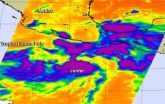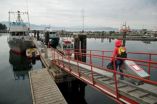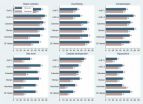(Press-News.org) A new point-of-care test to measure CD4 T-cells, the prime indicator of HIV disease progression, can expedite the process leading from HIV diagnosis to antiretroviral therapy (ART) and improve clinical outcomes. Now a study by Massachusetts General Hospital (MGH) investigators, working in collaboration with colleagues in Mozambique and South Africa, indicates that routine use of point-of-care CD4 testing at the time of HIV diagnosis could be cost effective in countries where health care and other resources are severely limited. Their analysis is being published in the public-access journal, PLOS Medicine.
"In severely resource-limited settings, too many people learn that they have HIV but then never initiate care," explains Emily Hyle, MD, MGH Division of Infectious Diseases, lead author of the PLOS Medicine paper. "Point-of-care CD4 tests can help more people reach care. But it is critical to evaluate the implementation of any technology more expensive than current care to be sure the investment is a wise one. Our mathematical model, based on the situation in Mozambique, found that point-of-care CD4 testing at the time of HIV diagnosis was very cost effective, as long as patients then have access to ART."
In most regions of sub-Saharan Africa, when an individual is diagnosed with HIV the standard procedure is to send blood samples to an external laboratory for CD4 testing. Patients must then return to the clinic to learn their test results, which determine whether they meet local standards to receive ART, and additional visits are often required to educate patients on the procedures necessary for successful treatment. Patients may have limited ability to travel back and forth to clinics that are far from their home communities and require taking a day off from work, so many fail to return after initial diagnosis and never receive the care they need. A point-of-care test can reveal an individual's CD4 result the same day as the original diagnosis, allowing expedited initiation of ART for those who meet local standards.
Conducted in collaboration with the Clinton Health Access Initiative, the MGH-led study used an established mathematical model of the natural history of HIV infection – including outcomes related to diagnosis and treatment initiation – to simulate adoption of point-of-care CD4 testing at an HIV testing and counseling clinic in Mozambique. Previous studies in that country, some conducted by co-authors of the current report, indicated that the availability of point-of-care CD testing improved patients' linkage to continued care but did not evaluate the costs associated with the test itself and with the initiation of ART.
The current analysis revealed that the information quickly provided by point-of-care CD4 would allow more patients to receive treatment sooner than if laboratory testing was used, resulting in almost one full year of additional life expectancy. With a cost-per-year-of-life-saved of $500 – less than Mozambique's per-capita GDP of $570 – point-of-care testing meets standards to be considered "very cost effective."
The authors note that, since their model used the least favorable estimates for the accuracy and costs of the point-of-care test, the actual cost effectiveness could be even greater. They also examined scenarios reflecting situations in other sub-Saharan countries, some with less stringent standards for ART eligibility and others with reduced access to care. The model indicated that point-of-care testing would have the greatest clinical impact and be most cost effective in areas with fewer opportunities for patients to reach care if they had not initiated care at the time of their initial diagnosis.
"Many types of point-of-care testing are of value in resource-limited settings, especially those with limited capacity for convenient or frequent clinic visits. The rapid turnaround provided by point-of-care CD4 testing can substantially improve clinical outcomes and be cost-effective," says Rochelle Walensky, MD, MPH, MGH Infectious Disease, senior author of the report. "Further studies are needed to investigate point-of-care CD4 testing for monitoring of patients who have started on ART in order to determine whether treatment is effective or should be changed to other, more expensive options."
INFORMATION:
Walensky is a professor of Medicine, and Hyle is an instructor in Medicine at Harvard Medical School. Additional authors of the PLOS Medicine report are Amanda Su, Ingrid Bassett, MD, MPH, Pamela Pei, PhD, and Kenneth Freedberg, MD, MSc, MGH; Elena Losina, PhD, Brigham and Women's Hospital; Ilesh Jani, MD, PhD, Instituto Nacional de Saùde, Maputo, Mozambique; Jonathan Lehe, Jorge Quevedo and Trevor Peter, PhD, Clinton Health Access Initiative, Maputo, Mozambique; Robin Wood, FCP, MMed, DTM&H, University of Cape Town, South Africa; David Paltiel, PhD, Yale School of Public Health; and Stephen Resch, PhD, Harvard School of Public Health.
Funding for this study includes National Institute of Allergy and Infectious Disease grants T32 AI 007433, R01 AI058736, R01 MH090326 and R01 AI0932690, as well as grants from the U.K. Department for International Development and the Clinton Health Access Initiative.
Massachusetts General Hospital, founded in 1811, is the original and largest teaching hospital of Harvard Medical School. The MGH conducts the largest hospital-based research program in the United States, with an annual research budget of more than $785 million and major research centers in HIV/AIDS, cardiovascular research, cancer, computational and integrative biology, cutaneous biology, human genetics, medical imaging, neurodegenerative disorders, regenerative medicine, reproductive biology, systems biology, transplantation biology and photomedicine.
Point-of-care CD4 testing is economically feasible for HIV care in resource-limited areas
Model suggests point-of-care testing most cost-effective in areas where patients have reduced access to care
2014-09-16
ELSE PRESS RELEASES FROM THIS DATE:
Nanoribbon film keeps glass ice-free
2014-09-16
Rice University scientists who created a deicing film for radar domes have now refined the technology to work as a transparent coating for glass.
The new work by Rice chemist James Tour and his colleagues could keep glass surfaces from windshields to skyscrapers free of ice and fog while retaining their transparency to radio frequencies (RF).
The technology was introduced this month in the American Chemical Society journal Applied Materials and Interfaces.
The material is made of graphene nanoribbons, atom-thick strips of carbon created by splitting nanotubes, ...
Journal of Clinical Psychiatry: Long-term benefit of NeuroStar TMS Therapy in depression
2014-09-16
Malvern, Pennsylvania, September 16, 2014 – Neuronetics, Inc., today announced that results of a study designed to assess the long-term effectiveness of NeuroStar TMS Therapy in adult patients with Major Depressive Disorder (MDD) who have failed to benefit from prior treatment with antidepressant medications, were published online in The Journal of Clinical Psychiatry. The study found that TMS treatment with the NeuroStar TMS Therapy System induced statistically and clinically meaningful response and remission in patients with treatment resistant MDD during the acute phase ...
NASA spots center of Typhoon Kalmaegi over Hainan Island, headed for Vietnam
2014-09-16
NASA's Aqua satellite saw Typhoon Kalmaegi's center near northern Hainan Island, China when it passed overhead on September 16 at 06:00 UTC (2 a.m. EDT). Hours later, the storm crossed the Gulf of Tonkin, the body of water that separates Hainan Island from Vietnam, and was making landfall there at 11:30 a.m. EDT.
The Moderate Resolution Imaging Spectroradiometer or MODIS instrument aboard Aqua captured a picture of the typhoon that shows the center near the northern end of Hainan Island, China, while the storm stretches over the mainland of southeastern China, east into ...
Computerized emotion detector
2014-09-16
Face recognition software measures various parameters in a mug shot, such as the distance between the person's eyes, the height from lip to top of their nose and various other metrics and then compares it with photos of people in the database that have been tagged with a given name. Now, research published in the International Journal of Computational Vision and Robotics looks to take that one step further in recognizing the emotion portrayed by a face.
Dev Drume Agrawal, Shiv Ram Dubey and Anand Singh Jalal of the GLA University, in Mathura, Uttar Pradesh, India, suggest ...
Newborn Tropical Storm Polo gives a NASA satellite a 'cold reception'
2014-09-16
The AIRS instrument aboard NASA's Aqua satellite uses infrared light to read cloud top temperatures in tropical cyclones. When Aqua passed over newborn Tropical Storm Polo off of Mexico's southwestern coast it got a "cold reception" when infrared data saw some very cold cloud top temperatures and strong storms within that hint at intensification.
Polo formed close enough to land to trigger a Tropical Storm Watch for the southwestern coast of Mexico. The watch was issued by the government of Mexico on September 16 and extends from Zihuatanejo to Cabo Corrientes, Mexico. ...
EARTH Magazine: The Bay Area's next 'big one could strike as a series of quakes
2014-09-16
Alexandria, Va. — Most people are familiar with the Great 1906 San Francisco Earthquake and are aware of the earthquake risk posed to the Bay Area — and much of California — by the San Andreas Fault. Most people are not aware, however, that a cluster of large earthquakes struck the San Andreas and quite a few nearby faults in the 17th and 18th centuries. That cluster, according to new research, released about the same amount of energy throughout the Bay Area as the 1906 quake. Thus, it appears that the accumulated stress on the region's faults could be released in a series ...
New research decodes virus-host interactions in ocean dead zones
2014-09-16
A complex web of interaction between viruses, bacteria, and their environment is becoming ever more untangled by a growing international collaboration between Matthew Sullivan, associate professor in the University of Arizona's Department of Ecology and Evolutionary Biology and Steven Hallam from the University of British Columbia in Vancouver, Canada.
"Bacteria are drivers of nutrient and energy cycles that power the earth," Sullivan said. "As the climate is changing, so are the environments these bacteria live in, and they in turn loop back to impact their environments. ...
New research shows tornadoes occurring earlier in 'Tornado Alley'
2014-09-16
BOZEMAN, Mont. -- Peak tornado activity in the central and southern Great Plains of the United States is occurring up to two weeks earlier than it did half a century ago, according to a new Montana State University study whose findings could help states in "Tornado Alley" better prepare for these violent storms.
Tornado records from Nebraska, Kansas, Oklahoma, and northern Texas – an area of high tornado activity dubbed "Tornado Alley" -- show that peak tornado activity is starting and ending earlier than it did 60 years ago.
Peak tornado activity, which occurs ...
Long-term results of RTOG 0236 confirm good primary tumor control, positive 5-year survival rates
2014-09-16
San Francisco, September 15, 2014—Patients with inoperable, early-stage lung cancer who receive stereotactic body radiation therapy (SBRT) have a five-year survival rate of 40 percent, according to research presented today at the American Society for Radiation Oncology's (ASTRO's) 56th Annual Meeting. Such a positive survival rate is encouraging considering that historically conventional RT resulted in poor tumor control for patients with inoperable lung cancer. This study is an update of RTOG 0236, originally published in 2010 , and also conducted by the original researchers ...
Politics divide coastal residents' views of environment, UNH research finds
2014-09-16
DURHAM, N.H. – From the salmon-rich waters of Southeast Alaska to the white sand beaches of Florida's Gulf Coast to Downeast Maine's lobster, lumber and tourist towns, coastal residents around the U.S. share a common characteristic: their views about coastal environments divide along political lines. That's a primary finding of a new study by University of New Hampshire sociologists published this month in the journal Society & Natural Resources.
"We found a lot of environment-related differences from place to place to place. Each environment is different so that's just ...
LAST 30 PRESS RELEASES:
University of Oklahoma researcher awarded funding to pursue AI-powered material design
Exploring how the visual system recovers following injury
Support for parents with infants at pediatric check-ups leads to better reading and math skills in elementary school
Kids’ behavioral health is a growing share of family health costs
Day & night: Cancer disrupts the brain’s natural rhythm
COVID-19 vaccination significantly reduces risk to pregnant women and baby
The role of vaccination in maternal and perinatal outcomes associated with COVID-19 in pregnancy
Mayo Clinic smartwatch system helps parents shorten and defuse children's severe tantrums early
Behavioral health spending spikes to 40% of all children’s health expenditures, nearly doubling in a decade
Digital cognitive behavioral treatment for generalized anxiety disorder
Expenditures for pediatric behavioral health care over time and estimated family financial burden
Air conditioning in nursing homes and mortality during extreme heat
The Alps to lose a record number of glaciers in the next decade
What makes a good proton conductor?
New science reporting guide published for journalists in Bulgaria
New international study reveals major survival gaps among children with cancer
New science reporting guide published for journalists in Turkey
Scientists develop a smarter mRNA therapy that knows which cells to target
Neuroanatomy-informed brain–machine hybrid intelligence for robust acoustic target detection
Eight SwRI hydrogen projects funded by ENERGYWERX
The Lundquist Institute and its start-up company Vitalex Biosciences Announces Strategic Advancement of Second-Generation fungal Vaccine VXV-01 through Phase 1 Trials under $40 Million Competitive Con
Fine particles in pollution are associated with early signs of autoimmune disease
Review article | Towards a Global Ground-Based Earth Observatory (GGBEO): Leveraging existing systems and networks
Penn and UMich create world’s smallest programmable, autonomous robots
Cleveland researchers launch first major study to address ‘hidden performance killer’ in athletes
To connect across politics, try saying what you oppose
Modulating key interaction prevents virus from entering cells
Project explores barriers to NHS career progression facing international medical graduates
Jeonbuk National University researchers explore the impact of different seasonings on the flavor perception of Doenjang soup
Two Keck Medicine of USC Hospitals named Leapfrog Top Teaching Hospitals
[Press-News.org] Point-of-care CD4 testing is economically feasible for HIV care in resource-limited areasModel suggests point-of-care testing most cost-effective in areas where patients have reduced access to care



